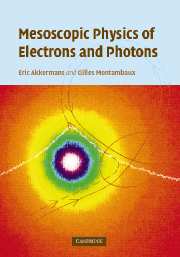Book contents
- Frontmatter
- Contents
- Preface
- How to use this book
- 1 Introduction: mesoscopic physics
- 2 Wave equations in random media
- 3 Perturbation theory
- 4 Probability of quantum diffusion
- 5 Properties of the diffusion equation
- 6 Dephasing
- 7 Electronic transport
- 8 Coherent backscattering of light
- 9 Diffusing wave spectroscopy
- 10 Spectral properties of disordered metals
- 11 Universal conductance fluctuations
- 12 Correlations of speckle patterns
- 13 Interactions and diffusion
- 14 Orbital magnetism and persistent currents
- 15 Formulary
- References
- Index
13 - Interactions and diffusion
Published online by Cambridge University Press: 06 January 2010
- Frontmatter
- Contents
- Preface
- How to use this book
- 1 Introduction: mesoscopic physics
- 2 Wave equations in random media
- 3 Perturbation theory
- 4 Probability of quantum diffusion
- 5 Properties of the diffusion equation
- 6 Dephasing
- 7 Electronic transport
- 8 Coherent backscattering of light
- 9 Diffusing wave spectroscopy
- 10 Spectral properties of disordered metals
- 11 Universal conductance fluctuations
- 12 Correlations of speckle patterns
- 13 Interactions and diffusion
- 14 Orbital magnetism and persistent currents
- 15 Formulary
- References
- Index
Summary
In this chapter v0is the average density of states per spin direction and ρ0 = v0/Ω is the density of states per unit volume. The energy Δ = 1/(ρ0Ω) = 1/v0is the average level spacing per spin direction. Most results will be presented in the CGS system, in the form most commonly found in the literature. Unless specified, we take ħ = 1.
Introduction
Up to this point, electron–electron interaction has been neglected in the description of spectral properties and electronic transport. Although electrons interact through the Coulomb interaction, the free electron model is a very good approximation for the description of many physical properties. This is due to the screening of the Coulomb interaction which occurs on a length of the order of the average distance between electrons. However, the electron–electron interaction has important physical consequences which can be classified in two categories.
Each electron is sensitive not only to the disorder potential but also to the electronic density fluctuations induced by other electrons. As a result, the energy levels are shifted and the thermodynamic and transport properties are modified, particularly the density of states and the conductivity. The change in density of states is maximum around the Fermi level, thus constituting a direct signature of the interaction. Moreover, this change is important since it affects the orbital magnetism of the electron gas and the persistent current (Chapter 14). The change in conductivity is of the same order of magnitude as the weak localization correction, but its nature is quite different. In particular, it does not depend on the magnetic field, making it more difficult to observe.
[…]
- Type
- Chapter
- Information
- Mesoscopic Physics of Electrons and Photons , pp. 465 - 515Publisher: Cambridge University PressPrint publication year: 2007

